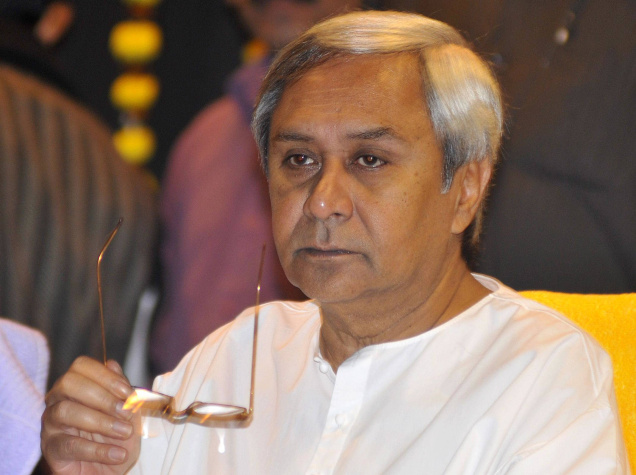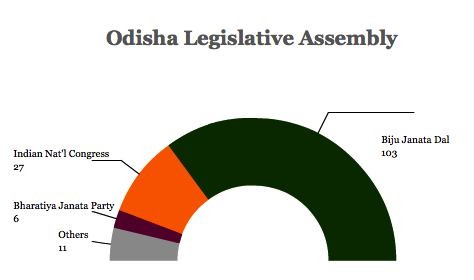Naveen Patnaik is one of India’s longest-serving chief ministers — and one of its most popular.![]()
Though his chances of winning a fourth consecutive term in Odisha’s state government are high, he faces a difficult challenge in state elections that are being held concurrently with national elections to determine India’s next government. Odisha holds the second of two phases — the first was on April 10 — to elect its 21 representatives to the national parliament, as well as all 147 members of its state-level Legislative Assembly.
Odisha, with 41.95 million residents, is basically as populous as Argentina. It’s a sprawling state on the central coast of eastern India, nudged to the southwest of West Bengal and Bangladesh. Formerly known as Orissa, the state is the home of most of India’s Oriya/Odia language speakers. It’s one of the most Hindu states in India (over 94% of the population), with a larger Christian population (2.4%) than Muslim population (2.1%).
Politics in Odisha are essentially a three-party affair, including the familiar national parties, the center-left Indian National Congress (Congress, भारतीय राष्ट्रीय कांग्रेस) and the center-right, Hindu nationalist Bharatiya Janata Party (the BJP, भारतीय जनता पार्टी).
But echoing an increasing trend throughout India, the dominant state-level party for more than a decade now has been the Biju Janata Dal (BJD, ବିଜୁ ଜନତା ଦଳ), which holds an overwhelming advantage in the Legislative Assembly:
Patnaik, like so many Indian politicians, is the son of another prominent politician — Biju Patnaik, who served as chief minster in the 1960s and again in the 1990s. Biju Patnaik was something of an interesting character in Asian politics. He cut his teeth in the Indonesian struggle for independence before returning to India as an ally of Jawaharlal Nehru, one of modern India’s founding fathers and its first prime minster. He eventually broke with Nehru’s daughter, prime minister Indira Gandhi, and he was one of the first officials that Gandhi imprisoned during ‘Emergency’ rule between 1975 and 1977. Upon his release, he became a leader in the Janata Dal Party that first came to power nationally in 1977, and he served in either national or regional politics until his death in 1997.
Naveen got his start when he won his father’s seat in the Lok Sabha (लोक सभा), the lower house of India’s parliament, in 1996, then as a member of the Janata Dal. He actually split with Janata Dal over its refusal to ally with the BJP that year, and he formed the BJD, whose name commemorates Naveen’s father, in 1997.
The BJD won for the first time in Odisha in 2000, initially in alliance with the BJP, though the BJD itself is, ideologically speaking, more to the center-left / social democratic side of the spectrum. It was only in the last election, in 2009, when the BJD pulled out the BJP-led National Democratic Alliance (NDA).
For now, the BJD is essentially a personal vehicle for Naveen Patnaik, who has impressively managed to retain his image as an incorruptible chief minister for the past 14 years — it’s all the more impressive considering that Patnaik, who didn’t grow up in Odisha, doesn’t even speak Oriya/Odia, the first language of over four-fifths of the state’s population.
Though the BJD is currently a member of the ‘third front’ of regional and leftist parties that hope to offer an alternative to both Congress and the BJP, it will almost certainly be one of the first groups to which the BJP might look if it falls short of the 272 mark in the Lok Sabha after national elections. If the BJD holds onto at least two-thirds of its Lok Sabha seats in Odisha, as polls predict it will, that would make it one of the largest parties in any future BJP-led coalition at the Centre.
This time around, with a wave of national dissatisfaction with a decade of Congress rule, and with an almost equally large wave of enthusiasm for the BJP’s Narendra Modi, the BJD stands not only to lose some of its state-level seats to India’s national parliament to the BJP, but also some of its seats within Odisha’s Legislative Assembly.
Though Patnaik parted ways with his political mentor Pyari Mohan Mohapatra two years ago under murky circumstances, his record remains strong in Odisha. State GDP per capita more than doubled between 2000 and 2010, and state outlays actually increased by a factor of eight between 2000 and 2014. Patnaik also received high marks for his administration’s handling of the evacuation, cleanup and rescue efforts during October 2012’s cyclone Phailin.
It’s nearly impossible to separate the state and national politics. If Patnaik and the BJD don’t win a majority in the state elections, and they have to turn to the BJP to remain in power in Odisha, it makes it almost certain that the BJD would boost the BJP nationally as well — and with polls showing that Modi and the NDA are hovering just around the 272 mark, Patnaik could well become more than just a four-term chief minister.
Photo credit to Ashoke Chakrabarty.

